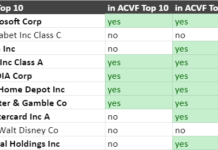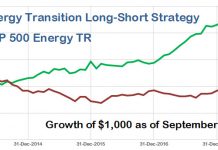A few months ago, I conducted analyses of the wind and solar power ETFs. I’ve recently turned my attention to the general alternative energy ETFs, or those that span several sectors.
The general alt energy ETFs fall into two categories: 1) US Only and 2) Global. The US Only ETFs are the First Trust NASDAQ Clean Edge US Liquid (QCLN) and the PowerShares Clean Energy (PBW). The Global ETFs are the iShares S&P Global Clean Energy Index ETF (ICLN), the PowerShares Global Clean Energy Portfolio (PBD) and the Van Eck Global Alternative Energy Fund (GEX).
The chart below shows 1-year’s worth of weekly returns for the five ETFs. You can click on the chart for an expanded view if you are having difficulty reading it.
The table below provides a few key statistics on the ETFs.
| Ticker | May 22 Price ($) | Expense Ratio (%) | 1-yr Return (%) | St Dev of Returns (%) | 6-mth Return (%) | Holdings (# of stocks) |
| PBD | 14.55 | 0.70 | (49.3) | 4.2 | 25.6 | 77 |
| QCLN | 12.75 | 0.60 | (52.5) | 4.3 | 19.7 | 78 |
| GEX | 25.00 | 0.65 | (53.9) | 5.1 | 18.7 | 28 |
| ICLN | 22.96 | 0.48 | (56.5) | 5.2 | 17.9 | 37 |
| PBW | 9.19 | 0.70 | (58.6) | 4.4 | 8.8 | 80 |
As the data in the table demonstrates, there is more to picking the right alt energy ETF than simply looking at the expense ratio. PBD, at a hefty 0.7%, has outperformed its peer group with lower volatility over the past year.
For example, $1,000 invested invested into PBD six months ago would have been worth $1,256 pre-expense on May 22, 2009, and $1,249 post-expense. The same $1,000 invested in ICLN, the ‘cheapest’ of the group, would have been worth, respectively, $1,179 and $1,174 on May 22. Moreover, PBD would have acheived this performance with a lower standard deviation – i.e. volatility – than ICLN.
While one would need to test for statistical significance before making any hard conclusions about outperformance, these results certainly suggest that, when it comes to picking an alt energy ETF, one must dig deeper than simply the expense ratio, as strong outperformance in the long run can more than make up for a few basis points in extra cost.
Alt Energy & Cleantech Sector Allocation
The table below lists out the percentages of total fund assets invested into the AltEnergyStocks.com alternative energy Categories. I had to make a few judgment calls on how to categorize certain firms, with the most frequent overlap being between Energy Efficiency and Electric Grid.
It must also be said that a few of the stocks held by the ETFs, especially those that I categorized as belonging to the Energy Efficiency Category, would not qualify as either alternative energy or energy efficiency for more purist alt e investors. QCLN, in particular, holds a number of power management stocks that do not appear to be primarily, if at all, targeting environmental opportunities.
| % Of Fund Value Invested In Each Category | |||||
| Category | PBD |
QCLN | GEX | ICLN | PBW |
| Solar | 35.3 | 36.8 | 34.9 | 51.2 | 36.1 |
| Wind | 20.0 | 6.4 | 24.8 | 17.9 | 5.7 |
| Power Production | 17.2 | 0 | 17.2 | 23.9 | 5.3 |
| Energy Efficiency | 9.1 | 40.2 | 11.6 | 0 | 13.9 |
| Ethanol | 4.0 | 0 | 1.0 | 0 | 3.5 |
| Battery | 3.2 | 5.4 | 0 | 0 | 10.4 |
| Geothermal | 2.5 | 4.8 | 1.1 | 2.1 | 9.0 |
| Waste-to-Energy | 1.4 | 0 | 3.8 | 4.0 | 0 |
| Fuel Cell | 1.2 | 1.1 | 0 | 0.5 | 1.5 |
| Electric Grid | 1.2 | 1.2 | 0 | 0 | 2.7 |
| Biodiesel | 0.7 | 0 | 0 | 0 | 0.6 |
| Clean Transportation | 0.7 | 0 | 0.3 | 0 | 4.5 |
| Biomass | 0.5 | 0 | 0 | 0 | 0 |
| Microturbine | 0.4 | 0 | 0 | 0 | 0 |
| Environmental Markets | 0.3 | 0 | 0 | 0 | 0 |
| Electricity Storage | 0.3 | 3.7 | 0 | 0 | 1.2 |
| Hydro | 0 | 0 | 0.7 | 0 | 0 |
| Ocean Power | 0 | 0 | 0 | 0 | 0.4 |
| Hydrogen | 0 | 0 | 0 | 0 | 2.0 |
| Other | 2.0 | 0.4 | 4.6 | 0 | 3.2 |
This table helps shed some light on the reasons behind the higher expense ratios for some ETFs. PBW and PBD, for example, hold 80 and 77 stocks, respectively, and span 15 and 18 categories. ICLN, by contrast, holds 37 stocks and spans only six categories. This wider coverage accounts, in part, for higher costs, although it also results in lower volatility.
QCLN stands out with the 3rd lowest expense ratio, a 78-stock portfolio, the second lowest standard deviation and the second highest returns over the past year. It spans nine Categories and has by far the heaviest weighting in Energy Efficiency (this may be good depending on your view of the sector).
PBW also stands out as the definite dog, which may appear counter-intuitive seeing as it tracks an index by the same provider as PBD. The answer partly lies in the ETF’s US focus.
PBD’s top ten holdings, accounting for ~32% of total fund value, span three categories: Wind, Solar and Power Production. There is only one US-listed company, Suntech Power (STP), with the balance accounted for by some leading European wind firms like Vestas (VWSYF.PK) or renewable power developers like Iberdrola Renovables (IRVSF.PK).
Most of alt energy’s best and most profitable companies are not based in the United States, conferring the Global ETFs an advantage in constructing their portfolios. This advantage stands out when comparing the quality of top holdings in PBD vs. PBW.
Despite this, QCLN managed to perform well because of its heavy concentration in Energy Efficiency and Solar. Together, stocks in these two Categories account for 77% of fund value. By contrast, Solar and Efficiency account for only 50% of PBW’s value. Both sectors have experienced strong upside over the past few weeks on the back of the Obama plan and the Chinese stimulus package.
Thus, while QCLN holds a relatively large basket of stocks, it is fairly heavily concentrated Category-wise, which has allowed it to outperform along with its main Categories. PBW follows a very similar diversification approach to PDB but the risk spreading in the latter, because of the comparative lack of high-quality alt energy firms in the US, has led to mediocre performance. There is most likely also something to be said for the US stock picking abilities of PBW’s makers (or the lack thereof). The result has been a lousy stock mix that has largely missed out on the latest rally.
ICLN and GEX follow broadly similar approaches and asset allocation strategies between Categories, though investors in GEX should in principle benefit through lower volatility from a somewhat more diversified portfolio. In practice, their results are effectively the same both in terms of returns and standard deviation.
Deciding Where To Invest
Which clean energy ETF to invest in depends on what an investor wants to achieve.
1. Play The Obama Administration
The Categories most likely to outperform from recent Obama alt energy policies are: Energy Efficiency, Battery, Electric Grid, Wind and Geothermal. QCLN has a 58% weighting in these five categories vs. 42% for PBW. Besides this, QCLN has outperformed PBW over the past year at a lower cost and similar volatility. The choice here is clear.
2. Play The Conventional Global Sectors Aggressively
The conventional and most mature alt energy Categories are Wind, Solar and Power Production. PBD, ICLN and GEX have weightings in these three Categories of, respectively, 70%, 93% and 77%.
Because of its high concentration in target Categories and low cost, my pick here is ICLN if an investor wants to play a strong return to growth in wind and solar. The Power Production Category is made up of developers, IPPs and utilities with strong exposures to renewables. Those entities have been at the fore of wind’s growth for the past five years and will play a large role in solar going forward as ground-mounted installations expand their market share.
2. Play Global Alternative Energy ‘Conservatively’
For the investor who wants broad exposure to alternative energy with relatively low risk, my recommendation is PBD. Despite its high cost, it offers good diversification in terms of both individual stocks and Categories. Moreover, its strong performance over the past six months says something about the quality of the underlying index and, indirectly, about the index makers’ global stock picking capabilities.
Disclosure: None










Charles,
I very much like the way you looked at sector exposure of the various ETFs, and used that to to select your picks for each investment strategy. I do have a couple caveats, however:
1. In your discussion of past performance, you referred to “testing for statistical significance” of recent outperformance of different ETFs. Since ETFs are not actively managed, the main reason ofr differences in performance is most likely to be in the way the indexes they track weight different Alt Energy subsectors and companies within those sectors, and hence the short term relative performance of these ETFs is no more likely to be persistent than the relative performance of subsectors. To the extent that the investor does not have an opinion on the relative future performance of subsectors, the choice of a fund should not be made based on past performance, but on diversification (lower volatility) and fees.
2. I don’t think solar should be lumped with wind as “mature” sectors. Solar is still an immature sector, since it is still a few years from being economic without subsidies. In my mind, the mature sectors are the ones that are currently economic, or very close to it: Efficiency, Power Production, some Clean Transportation, some Transmission/Grid, Wind, and Geothermal.
Tom:
In order:
1) Agreed about what accounts for past performance, but I disagree on the implications. While past performance per se should not drive the decision of whether or not to buy an ETF, my argument is that it pays to be partial to sector and company allocation within the index, especially for shorter time horizons.
2) Good point. I guess I should have stuck to “conventional”, although I am not a fan of this term either. The problem with efficiency in this case is that many of the stocks I categorized as belonging to the “Efficiency” category were not, by and large, mature plays on this theme but rather the riskier, tech-like ones. In terms of grid, geothermal and transportation, the relative weight of these sectors in the alt energy ETFs is such that large increases would not be especially significant overall. What I meant to convey was that the heavy concentration into what is typically understood as the “conventional” alt energy sectors made the one ETF an attractive play because these conventional sectors are all expected to do well in the medium and long runs.
1. You’re right.
2. That sounds like the subject of a new article… instead of looking at sector break-down of the ETFs, it may make more sense to look at the profitability of the companies in question.
Hi,
I like your analysis of the ETF energy market. I am involved in trading but have become interested in ETFs however. Is there a simple way to invest in renewable energy that is not directly in the stock market. Say I had $1000, could I log on to a website and invest it directly in a percentage of a renewable energy fund or ETF? It seems to me alot of people would like to invest in renewables but dont want to dig deep into, the investment vehicles themselves, e.g. ETF’s. Prehaps some type for energy voucher. I guess I was thinking of simplifying the process of investing as to broaden the interest in it.
Patrick:
The one vehicle that allows people to invest directly in renewable energy (although I think that applies mostly to wind) as investors is a community project. I know this is big in Germany and I know of one project near Toronto but I don’t know how big it is in the US.
In such cases, people pool their money together to provide the equity in the wind project and get a payout over time as the project generates cash flows. Again, not sure how widespread this is in the US and how easy it is for individuals to get into.
The other thing you can do – if you live in a state with the right incentives – is put solar panels on your roof. I wrote an article a little while ago on the economics of this: http://www.altenergystocks.com/archives/2009/05/from_solar_2009_removing_the_2000_itc_cap.html